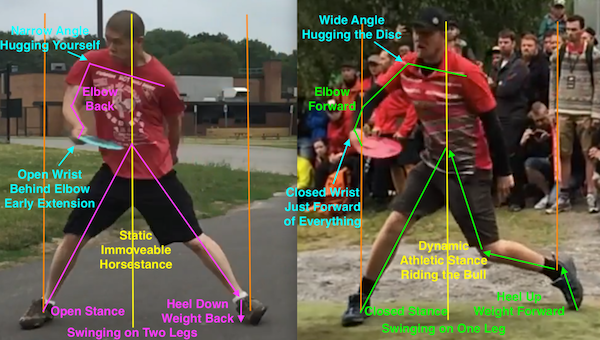I agree it is a mix of passive and active, so I'm not sure why you think the passive part should be dismissed in this discussion. Like I demonstrate in the vid and like Climo said it is very much like using a hammer, start loose and tighten at the hit to deliver blow, bam!
https://www.youtube.com/watch?v=v1pkfJtVq-8#t=3m20s
BlakeT used to talk about half-hitting vs full-hitting, and half-hitting is the passive whip which you must get to first before you can actively fully-hit. Half-hitting with limp arm will get your kinetic chain working in proper sequence.
Dave D has been teaching the tip of the whip since at least 2001.
https://www.dgcoursereview.com/dgr/resources/articles/distancesecrets.shtml
"Load your wrist and fingers lightly with the wrist down and the disc in the "launch" position so that it is only necessary to concentrate on acceleration and not form. The launch position is the position and orientation of the disc in your hand at the hit point. Regardless of whether the disc is at the hit point (launch) or in wind up, you have to hold the disc such that when it starts to pivot and rip out it will have the proper tilt and nose angle that you want the shot to have.
Keep your wrist cocked down but not curled back. Your wrist should be more or less in a hand shaking position but cocked down. You also need a wrist down position to have the disc flat to avoid off axis torquing (disc flutter) and severe loss of power. If you hold the disc in the pre-pivot position, all you have to do is put it at the hit spot and the angles will already be there. It works the same for a putt or an up shot. Not everyone does this, but it makes shots easier.
The upper arm muscles should not be pre-stiffened. Only the lower arm and wrist should be stiffened and you should only be using enough tension in your wrist and fingers to maintain the orientation of the hit. The launch position includes the position of the flight plate and most importantly the back of the disc at the time of launch.
Right before the hit starts the wrist will wag back slightly and then go forward slightly. This is when the part happens that's important to remember. Your wrist should not continue forward to sling the disc out; instead it should come to an abrupt, steely stop. At this point your wrist should be stiff and held motionless, so try to stiffen your fingers, wrist, and arm as much as possible at the moment of impact of the snap. It's similar to a karate chop in that there is very little wrist motion. You don't want to keep your wrist stiff throughout the whole throw, though. At the beginning of the throw you want to only have enough tension in the fingers and wrist to hold the disc in launch position.
You only become tight at the hit. Notice, too, that using the tendon bounce does not mean that your arm stops just because your wrist motion stops. The arm and shoulders must continue to pull through the snap with as much force as possible as the disc is ripping out of your fingers. Pulling through the hit with your hips and shoulders generates power."

